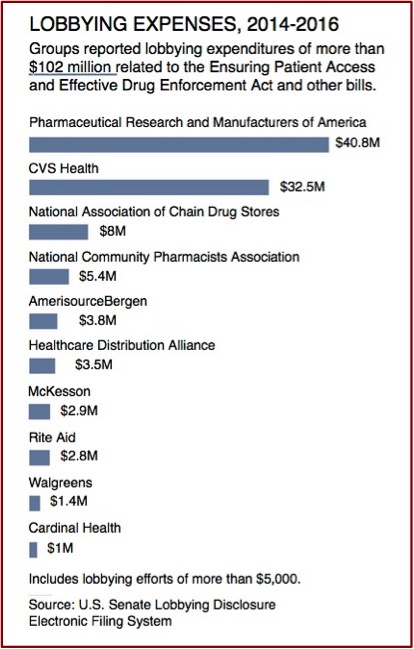
As a result of a Washington Post and “60 Minutes” investigation, Representative Tom Marino withdrew his name from consideration for the position of “drug czar,” Director of National Drug Policy. As the investigation showed, Marino had been the primary force behind what became the “Ensuring Patient Access and Effective Drug Enforcement Act of 2016.” Marino spent several years trying to get the legislation through Congress, and was finally successful when Senator Orin Hatch negotiated a final version of the bill with the DEA. What wasn’t readily apparent by the title of the bill—and sunk Marino’s chances of approval as the new drug czar—was that instead of ensuring effective drug enforcement, it hobbled the DEA’s ability to go after the drug companies suspected of enabling the widespread distribution of prescription pain medication.
The law was the crowning achievement of a multifaceted campaign by the drug industry to weaken aggressive DEA enforcement efforts against drug distribution companies that were supplying corrupt doctors and pharmacists who peddled narcotics to the black market. The industry worked behind the scenes with lobbyists and key members of Congress, pouring more than a million dollars into their election campaigns.
The DEA had opposed the legislation for years, but was finally outmaneuvered by the nation’s major drug distributors and a few members of Congress. The new law made it effectively impossible for the DEA to stop suspicious narcotic shipments from the companies. Despite being fined, some drug distributors had repeatedly ignored warnings from the DEA to shut down suspicious sales. “Overall, the drug industry spent $102 million lobbying Congress on the bill and other legislation between 2014 and 2016, according to lobbying reports.” Through various political action committees, the drug industry contributed over $1.5 million dollars to the 23 lawmakers who sponsored or co-sponsored four versions of the bill. Marino received $100,000; Hatch $177,000. See the following chart from the Washington Post article.
The drug industry, the manufacturers, wholesalers, distributors and chain drugstores, have an influence over Congress that has never been seen before,” said Joseph T. Rannazzisi, who ran the DEA’s division responsible for regulating the drug industry and led a decade-long campaign of aggressive enforcement until he was forced out of the agency in 2015. “I mean, to get Congress to pass a bill to protect their interests in the height of an opioid epidemic just shows me how much influence they have.
Besides the sponsors and co-sponsors, few lawmakers knew what the impact of the bill would really be. Apparently, the same was true for the White House as President Obama signed it into law without any comment. “It sailed through congress and was passed by unanimous consent, a parliamentary procedure reserved for bills considered to be noncontroversial.” Michael Botticelli, who was the drug czar at the time, said neither the DEA nor the Justice Department objected to the bill at the time, which removed a major obstacle to the president’s approval. All this suggests there was some serious behinds-the-scene maneuvering going on. “Neither the DEA nor the Justice Department informed OMB about the policy change in the bill.”
The DEA’s top official at the time, Chuck Rosenberg, declined repeated requests for interviews by the Washington Post and “60 Minutes”; as did Loretta Lynch, then the attorney general and Tom Marino. A spokesperson for former President Obama referred reporters to Botticelli’s statement. Additionally, the DEA and Justice Department repeatedly denied or delayed over a dozen requests filed by the Washington Post and “60 Minutes” under the Freedom of Information Act for public records that could give additional information on what happened. “Some of those requests have been pending for nearly 18 months.”
Another key player in the “Ensuring Patient Access and Effective Drug Enforcement Act of 2016” was a former associate chief counsel for the DEA, D. Lindon Barber. While working for the DEA, he helped design and implement the early phases of the agency’s enforcement campaign against drug companies that were failing to report suspicious orders of opioids. Barber was also one of dozens of DEA officials recruited by the drug industry over the past decade. He brought first hand knowledge of the DEA’s strategy and how it could be countered when he went over to the drug industry in 2011. According to an internal Department of Justice email, Barber has a central role in crafting early versions of the legislation. “’He wrote the Marino bill,’ the official wrote in 2014.”
With a few words, the new law changed four decades of DEA practice. Previously, the DEA could freeze drug shipments that posed an “imminent danger” to the community, giving the agency broad authority. Now, the DEA must demonstrate that a company’s actions represent “a substantial likelihood of an immediate threat,” a much higher bar. “There’s no way that we could meet that burden, the determination that those drugs are going to be an immediate threat, because immediate, by definition, means right now,” Rannazzisi said.Today, Rannazzisi is a consultant for a team of lawyers suing the opioid industry. Separately, 41 state attorneys general have banded together to investigate the industry. Hundreds of counties, cities and towns also are suing.“This is an industry that’s out of control. If they don’t follow the law in drug supply, and diversion occurs, people die. That’s just it, people die,” he said. “And what they’re saying is, ‘The heck with your compliance. We’ll just get the law changed.’”
Sadly, the limitations placed upon the DEA by the “Ensuring Patient Access and Effective Drug Enforcement Act of 2016” were reported by the LA Times soon after the law was passed in 2016, but no consequences occurred until the Washington Post and “60 Minutes” investigation led to Marino withdrawing his name for the position of drug czar. The LA Times noted how the law was backed by some of the same wholesalers, manufacturers and pharmacy chains targeted by the DEA for not doing enough to monitor and restrict the overflow of pills. The stalled legislation also moved through Congress after the resignation of Joseph Rannazzisi from the DEA in October of 2015. He left, in part, because of his view that the bill was “misguided and would worsen the epidemic.” He said: “They are taking the word of industry rather than the government’s expert in diversion control.”
In 2012 the DEA took action against a major national wholesaler of pharmaceuticals and medical products, Cardinal Health, Inc. Data had shown enough pain medication was supplied to two CVS pharmacies in Sanford FLA for every person in the small city to have 59 doses. The DEA accused Cardinal and CVS of failing to maintain “effective controls” against diversion. “Cardinal was banned from shipping prescription drugs from a Florida facility for two years and CVS paid a $22-million settlement.” Note that CVS lobbying expenditures above were $32.5 million, second only to PHRMA, a trade group representing companies in the pharmaceutical industry.
The above are only the most notable and recent actions of the venomous pharmaceutical lobby. The Milwaukee Journal Sentinel published a two-part article on how drug makers work behind the scenes fighting against measures aimed at fighting the tide of prescription painkillers flooding our nation. Part 1 said there is a state level strategy where “hundreds of lobbyists and millions of dollars in campaign contributions” are used to weaken or kill measures aimed at turning back the opioid epidemic. The Associated Press and the Center for Public Integrity found they often use funded advocacy groups to fight limits of drugs such as OxyContin, Vicodin and fentanyl.
Between 2006 and 2015, drug makers spent more than $880 million nationwide on lobbying and campaign contributions — more than 200 times what those advocating for stricter policies spent. For comparison, it’s also more than eight times what the formidable gun lobby recorded for advancing its agenda through similar activities during that same period.
There have been hundreds of opioid-related bills introduced at the state level over the past few years. The few groups fighting for tighter prescription restrictions are primarily grass roots organizations formed by family and friends of individuals killed by opioids. “Together, they spent about $4 million nationwide at the state and federal level on political contributions and lobbying from 2006 through 2015 and employed an average of eight state lobbyists each year.” Compared to estimated lobbying of drug companies, they are being outspent 220 to one.
Part 2 of the Journal Sentinel article highlighted the efforts of a little-known group called the Pain Care Forum. The organization has worked at both the national and state level to communicate the message of the vital role played by painkillers in the lives of millions of Americans. The Pain Care Forum is a loose coalition of drug-makers, trade groups and nonprofits supported by industry funding. A 2012 Pain Care Forum “Meetings Schedule” listed about 64 participating organizations, a mix of medical organizations, advocacy groups and pharmaceutical companies. Among the pharmaceutical companies were: Abbott Laboratories, Allergan, Eli Lily & Company, Endo Pharmaceuticals, Johnson & Johnson, Merck, Purdue Pharma LP, and Teva.
From 2006 through 2015, participants in the Pain Care Forum spent more than $740 million lobbying in the nation’s capital and in all 50 statehouses on an array of issues, including opioid-related measures, according to an analysis of lobbying filings by the Center for Public Integrity and the AP.The same organizations reinforced their influence with more than $140 million doled out to political campaigns, including more than $75 million alone to federal candidates, political action committees and parties.
Purdue’s Washington lobbyist co-founded the Pain Care Forum and coordinates the group’s meetings. The Pain Care Forum doesn’t have an online presence or a physical address, yet it hosts high-ranking officials from the White House, the FDA and other agencies at its monthly gatherings. While Forum members maintain it does not take policy positions, the AP and Center for Public Integrity have shown where the group’s participants worked together “to push and draft federal legislation, blunt regulations and influence decisions around opioids.” A major talking point is the false assumption of a conflict between reducing our dependence on opioids and improving care for patients with pain. “It’s an artificial conflict, but there are lots of vested interests behind it.”
Tom Marino will not be the new “drug czar,” and hopefully the media attention recently received by “Ensuring Patient Access and Effective Drug Enforcement Act of 2016” will result in Congress restoring the enforcement power to the DEA that the legislation removed. But since some legislators have been seduced by pharmaceutical money and influence, Congress may not have the collective will to resist the lobbying influence of Pharma companies. Therein lies the problem: how can you cut off the head of a snake if you depend on the snakes?





